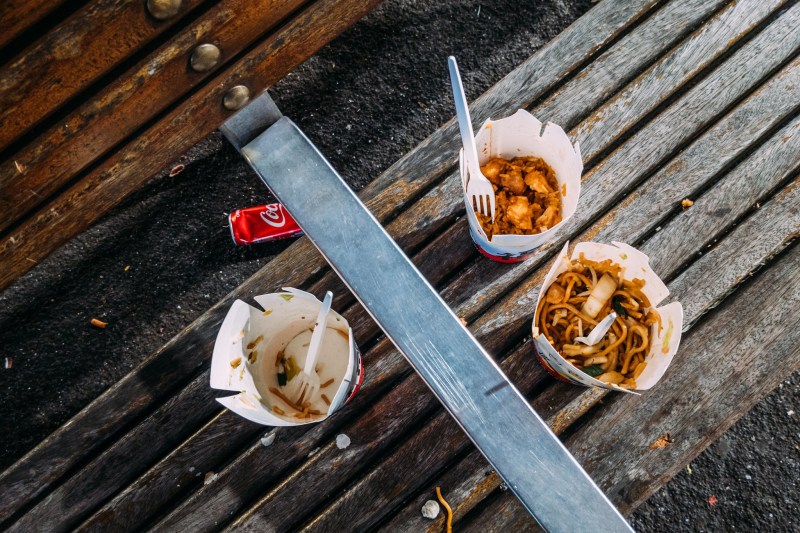Food safety is integral and could save your life and limbs. Don't believe it? Check out the story of a 19-year-old New England college student who, after “a freak accident happening in a perfect storm sequence of events,” had both his legs amputated after eating rice, chicken, and lo mein leftovers. The viral YouTube video "Chubbyemu," posted by Dr. Bernard Hsu, a licensed toxicologist, has since been viewed over 1.6 million times.
The lesson: Whether it’s making a dish from scratch or reheating leftovers like chicken wings, take care when you’re cooking. if you’re not sure of the correct procedure, The Manual is here to help relay suggestions from the U.S. Department of Agriculture’s Food Safety and Inspection Service.

The Food Danger Zone
Bacteria germinate exponentially between 40 degrees and 140 degrees Fahrenheit. Hot food must be kept above 140 degrees or warmer to prevent bacterial growth. After cooked food is removed from heat, leftovers must be refrigerated. If perishable foods are left out for more than two hours, toss them out. If you’re outside during the summertime and it’s over 90 degrees, toss it after one hour.
On the opposite end of the spectrum, cold foods like chicken salad or deli meats need to stay cold — 40 degrees Fahrenheit or below. Keep these eats cold by nesting dishes in bowls of ice or put what you're not using in the refrigerator. Similar to cooked foods, toss cold leftovers that have been left out for more than two hours at room temps or one hour when it’s over 90 degrees.
Quickly Cool Foods
It's important to cool food fast to prevent bacterial growth. First, make sure that your refrigerator is set at 40 degrees or lower. Next, make sure that you divide big dishes like bowls of soup or salad into smaller containers as these will take less time to cool. Same goes for big cuts of meat. Slice roasts and hams and separate birds or other whole-cooked animals into constituent parts.
You can encourage this chilling by setting these dishes into larger containers of ice or cold water.
Securely Seal Leftovers
Sealing leftovers will not only keep bacteria out, it will also help to preserve food. Cover food you want to keep in airtight packaging, plastic wrap, aluminum foil, or sealed in plastic or glass storage containers. This will help to prevent bacterial growth as well as thwarting cold air from drying food out, and keep it from picking up scents and tastes from other refrigerated goods.
Toss Out Old Leftovers
Leftovers might seem safe for long periods as long as they’re kept cool, but already cooked foods should only be retained for three or four days. To add some life to goods you want to sustain for more time (or are too much to consume in a few days), freeze them. Frozen foods keep for as long as they're unthawed, although they’ll lose taste and become freezer burned after three to four months.
Thaw Safely
When you choose to reheat frozen foods, you’re again encouraging bacterial growth. Instead of leaving foods to unfreeze at room temperatures, keep them cool or warm. This means tossing foods to thaw into the refrigerator, chilled or iced water, or into the microwave or warm oven instead. Refrigerator thawing may take a while, but, according to the USDA, is the safest method. Again, unthawed, cooled food should be eaten within three or four days after it’s unfrozen.
Foods thawed by cold water should always be recooked before refreezing. Make sure frozen leftovers are in a leak-proof package like a plastic bag. Otherwise, water can saturate the food, and bacteria from the surrounding environment are liable to get in.
Microwave thawing is quickest, but you’re essentially cooking the food. When microwaving frozen leftovers, heat them until the food reaches an internal temperature of 165 degrees (as measured with a food thermometer). Denser foods such as meats will take longer to heat than lighter goods like pasta, bread, fruits, and veggies.
It’s also safe to reheat frozen leftovers on the stovetop or in the oven. Reheating, of course, will take longer and potentially dry food out, so make sure to watch for dry meats or baked goods and add water, oil, or butter as needed. Soups or other liquids you should bring up to a rolling boil.
Even though it's extremely rare to lose limbs, eating improperly stored/thawed foods can lead to nasty gut sickness at least and a hospital bed at worst. Do your best to save food safely and try not to waste it as leftovers are some of the best treats out there. As long as you pay attention, it's easy to follow protocols to keep yourself and others safe in regards to heating and eating.



